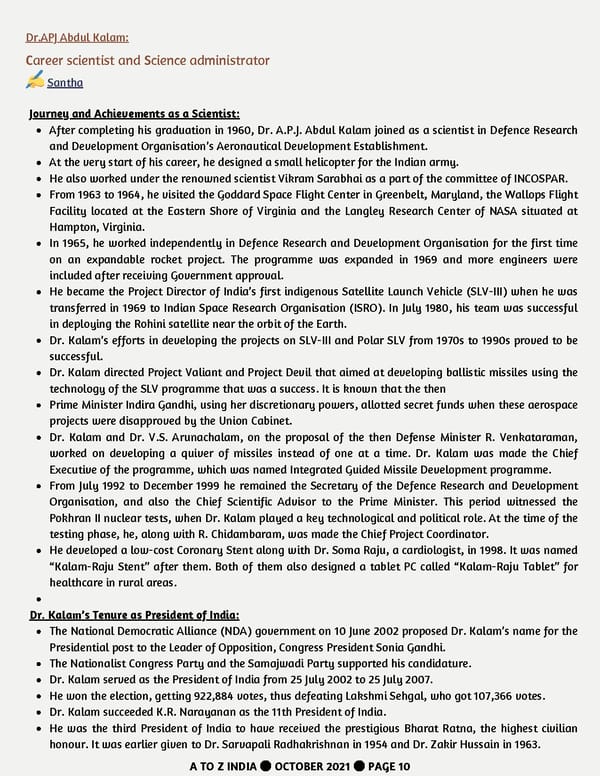Dr.APJ Abdul Kalam: Career scientist and Science administrator Santha Journey and Achievements as a Scientist: After completing his graduation in 1960, Dr. A.P.J. Abdul Kalam joined as a scientist in Defence Research and Development Organisation’s Aeronautical Development Establishment. At the very start of his career, he designed a small helicopter for the Indian army. He also worked under the renowned scientist Vikram Sarabhai as a part of the committee of INCOSPAR. From 1963 to 1964, he visited the Goddard Space Flight Center in Greenbelt, Maryland, the Wallops Flight Facility located at the Eastern Shore of Virginia and the Langley Research Center of NASA situated at Hampton, Virginia. In 1965, he worked independently in Defence Research and Development Organisation for the first time on an expandable rocket project. The programme was expanded in 1969 and more engineers were included after receiving Government approval. He became the Project Director of India’s first indigenous Satellite Launch Vehicle (SLV-III) when he was transferred in 1969 to Indian Space Research Organisation (ISRO). In July 1980, his team was successful in deploying the Rohini satellite near the orbit of the Earth. Dr. Kalam’s efforts in developing the projects on SLV-III and Polar SLV from 1970s to 1990s proved to be successful. Dr. Kalam directed Project Valiant and Project Devil that aimed at developing ballistic missiles using the technology of the SLV programme that was a success. It is known that the then Prime Minister Indira Gandhi, using her discretionary powers, allotted secret funds when these aerospace projects were disapproved by the Union Cabinet. Dr. Kalam and Dr. V.S. Arunachalam, on the proposal of the then Defense Minister R. Venkataraman, worked on developing a quiver of missiles instead of one at a time. Dr. Kalam was made the Chief Executive of the programme, which was named Integrated Guided Missile Development programme. From July 1992 to December 1999 he remained the Secretary of the Defence Research and Development Organisation, and also the Chief Scientific Advisor to the Prime Minister. This period witnessed the Pokhran II nuclear tests, when Dr. Kalam played a key technological and political role. At the time of the testing phase, he, along with R. Chidambaram, was made the Chief Project Coordinator. He developed a low-cost Coronary Stent along with Dr. Soma Raju, a cardiologist, in 1998. It was named “Kalam-Raju Stent” after them. Both of them also designed a tablet PC called “Kalam-Raju Tablet” for healthcare in rural areas. Dr. Kalam’s Tenure as President of India: The National Democratic Alliance (NDA) government on 10 June 2002 proposed Dr. Kalam’s name for the Presidential post to the Leader of Opposition, Congress President Sonia Gandhi. The Nationalist Congress Party and the Samajwadi Party supported his candidature. Dr. Kalam served as the President of India from 25 July 2002 to 25 July 2007. He won the election, getting 922,884 votes, thus defeating Lakshmi Sehgal, who got 107,366 votes. Dr. Kalam succeeded K.R. Narayanan as the 11th President of India. He was the third President of India to have received the prestigious Bharat Ratna, the highest civilian honour. It was earlier given to Dr. Sarvapali Radhakrishnan in 1954 and Dr. Zakir Hussain in 1963. A TO Z INDIA ● OCTOBER 2021 ● PAGE 10
 A TO Z INDIA - OCTOBER 21 Page 9 Page 11
A TO Z INDIA - OCTOBER 21 Page 9 Page 11